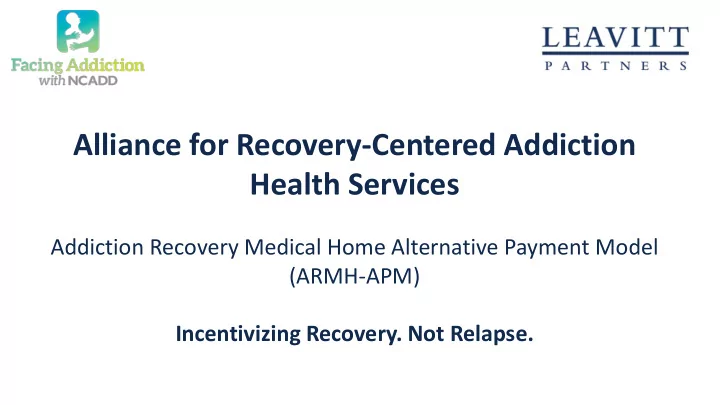

Alliance for Recovery-Centered Addiction Health Services Addiction Recovery Medical Home Alternative Payment Model (ARMH-APM) Incentivizing Recovery. Not Relapse.
The Alliance for Recovery-Centered Addiction Health Services 2
Publication Contributors & Reviewers CONTRIBUTING MEMBERS REVIEWERS & SUBJECT Altarum Institute MATTER EXPERTS America’s Health Insurance Plans Tom Coderre Caron Treatment Centers Franc̨ois de Brantes Magellan Health Kevin Dorrance The National Committee for Quality Assurance Kimber Falkinburg The National Council on Behavioral Health Keith Humphreys Patient-Centered Primary-Care Collaborative John F. Kelly TransformCare Anna Lembke Recovery Research Institute Carol McDaid Utah Support for Addiction Recovery Awareness Benjamin F. Miller Well Being Trust John O’Brien Brendan Saloner PUBLICATION EDITORS Aditi P. Sen Anne Marie Polak, Leavitt Partners William L. White David Smith, Third Horizon Strategies Greg Williams, Facing Addiction With NCADD 3
ARMH-APM Principles 1. Recovery from Substance Use Disorder (SUD) is a process of change whereby individuals achieve SUD remission, work to improve their own health and wellness, and live a meaningful life in a community of their choice while striving to achieve their full potential. 2. Care recovery has three critical, interconnected states: pre-recovery/stabilization, recovery initiation and active treatment, and community-based recovery management . 3. Recovery management requires a multi-disciplinary care recovery team who can provide the diverse biopsychosocial elements of treatment needed and is critical in creating optimal conditions for recovery and improving personal, family, and community recovery capital . 4. A well-managed and broad continuum of care ranging from emergent and stabilizing acute-care settings to community-based services and support is essential to managing patient needs across the stages of personal and family recovery. 5. Clinical and non-clinical recovery support asset across a continuum of care should be integrated , allowing for a sharing of patient information, high-functioning care transitions, and commensurate clinical and safety standards . 4
ARMH-APM Principles 6. Co-morbidities and co-occurring mental health challenges must be managed in concert with the underlying treatment and recovery of a SUD, with a care recovery team facilitating timely and consistent feedback and appropriate information sharing within the patient-centered medical community. 7. Recovery support strategies must accommodate and support the growing varieties of SUD recovery and the broader spectrum of alcohol and other drug problem solving experiences . There are no static SUD cases, requiring a model sufficiently malleable to accommodate for multiple pathways and styles of alcohol and other substance problem resolutions, including a subclinical focus. 8. Integrating economic benefits and risks between payers and the delivery system will promote greater accountability and care design to facilitate holistic and comprehensive care recovery environment for the patient. 9. SUD recovery is a life-long process, with five years of sustained substance problem resolution marking a point of recovery stability in which risk of future SUD recurrence equals the SUD risk within the general population. 10. A dynamic treatment and recovery plan with the breadth and flexibility to engender increased recovery capital should be authored in collaboration with the patient , the patient’s family, and other key social supports. 5
Five Key Elements to ARMH-APM Payment Model Treatment Quality and Recovery Metrics Plan ARMH- APM Key Elements Care Recovery Network Team 6
Payment Model – Episodes 1 • High clinical intensity and emergent situations • Episode 0 Unpredictable in nature (Includes Overdoses, MVA’s, Heart Attack’s, etc.) • Gateway to engagement in ARMH-APM Pre-Recovery and • Payments remain fixed on FFS; performance bonuses can be paid • Stabilization Timing can be variable – 1-30 days • Activation of care recovery team and treatment and recovery plan • Initial inclusion of the patient in the ARMH-APM and assimilation into the integrated treatment and Episode 1 recovery network • Covers specialty clinical resources from inpatient (as needed) to intensive outpatient Recovery Initiation and • Introduction of value payments Active Treatment • Timing can be for up to one year • Does not exclusively rely on specialty care settings, moving the locus of care closer to community / primary care Episode 2 • Increased emphasis on the treatment and recovery plan and community supports Community-Based • Risk factors decrease, although recovery disruptions are well-managed with patient closely linked to ongoing care Recovery Management • Timing can be for up to five years, depending on MCO continuity 7
ARMH-APM Payment Model 1 8
Payment Model – Episode Structure 1 9
Integrated Treatment and Recovery Network – Care Pathway (Episode 0) 2 10
Integrated Treatment and Recovery Network – Care Pathway (Episodes 1 & 2) 2 11
3 Care Recovery Team 12
Treatment and Recovery Plan - Components 4 1. Living (e.g., evaluate your living situation) Promoting Social 2. Recovery (e.g., build a support network) Controls 3. Relationships (e.g., find sober friends) 4. Healthy Body (e.g., pay attention to your body; co-morbid physical conditions) 5. Healthy Mind (e.g., focus on mental well-being; underlying behavioral Managing for health concerns) Stress and 6. Counseling (e.g., continue to see a therapist) 7. Medication (e.g., transition to a new doctor) Coping 8. School (e.g., do your homework) 9. Work (e.g., return to work) 10.Compliance (e.g., stick with your treatment plan) Behavioral 11.Spirituality (e.g., heal your spirit) Economics and 12.Interests (e.g., discover new ways to have fun) Choice 13.Coping Skills (e.g., practice healthy coping skills) 13
Quality & Measurement 5 • No current long-term quality measures for SUD • Partnering with The National Committee for Quality Assurance (NCQA) to develop • Initial pilots to rely heavily on process measures (e.g. patient consent to share medical record, frequency of patient contact, care transitions, etc.) • Lessons to be learned from the Collaborative Care Model being used in primary care • Emerging tools to measure a patient’s “Recovery Capital” will be explored • Following principles in ASAM consensus document for appropriate use of drug testing 14 14
Smart on Value Addiction Recovery Medical Home Alternative Payment Model (ARMH-APM) Incentivizing Recovery. Not Relapse. www.leavittpartners.com www.IncentivizeRecovery.org #IncentivizeRecovery info@incentivizerecovery.org
Recommend
More recommend